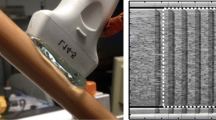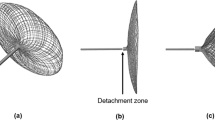Abstract
Approximately 40,000 people suffer brain aneurysm rupture and 2.5 million suffer a traumatic brain injury (TBI) each year in the USA. Cerebral vasospasm (CV) occurs as a complication of brain hemorrhage resulting from cerebral aneurysm rupture and TBI. CV causes further cerebral injury and is the primary cause of death and disability in aneurysmal hemorrhage and TBI. Consequently, it is critical to design a model for diagnosing and analyzing the abnormal cerebral blood flow velocity hemodynamics associated with CV. By generating such a model, it would be possible to design machine learning mechanisms for earlier prediction of CV. In previous studies, cerebrovascular models of blood flow behavior for different disorders were established. Unfortunately, those models are disorder specific and have too many parameters to tune. We have established a model for the signal envelope of the cerebral blood flow velocity that was produced by transcranial Doppler (TCD). We have applied it to simulate CV behavior, and it is general enough to be applied to other cerebrovascular disorders. The model is based on the delay differential equation as a representative modeling equation for three diagnostic categories: control (no CV or hyperemia), hyperemia, and CV. The model has only four tunable parameters and allows switching from one case to another by changing those parameters. After validation of the model, the generated envelope signals compared to spectrograms recorded by transcranial Doppler, demonstrated good concordance in all three categories between the model and signals acquired with TCD. This result could be used for modeling cerebral blood velocity abnormalities and lead to early detection of CV in TBI and aneurysmal hemorrhage.






Similar content being viewed by others
References
Dorsch, N.: A clinical review of cerebral vasospasm and delayed ischemia following aneurysm rupture. Acta Neurochir. 110, 5–6 (2011)
Shahlaie, K., et al.: Posttraumatic vasospasm detected by continuous brain tissue oxygen monitoring: treatment with intra-arterial verapamil and balloon angioplasty. Neurocrit. Care 10, 61–69 (2009)
National hospital discharge survey (2010)
National hospital ambulatory medical care survey (2010)
https://www.cdc.gov/traumaticbraininjury/basics.html. Accessed 10 Oct 2018
Macdonald, R.L., Pluta, R.M., Zhang, J.H.: Cerebral vasospasm after subarachnoid hemorrhage: the emerging revolution. Nat. Clin. Pract. Neurol. 3(5), 256–263 (2007)
Sabayan, B., et al.: Cerebrovascular hemodynamics in Alzheimer’s disease and vascular dementia: a meta-analysis of transcranial Doppler studies. Ageing Res Rev. 11, 271–277 (2012)
Roje-Bedekovic, M., Bosnar-Puretic, M., Lovrencic-Huzjan, A., Demarin, V.: Cerebrovascular evoked response to repetitive visual stimulation in severe carotid disease—functional transcranial Doppler study. Acta Clin. Croat. 49, 267–274 (2010)
Ferini-Strambi, L., Walters, A.S., Sica, D.: The relationship among restless legs syndrome (Willis–Ekbom disease), hypertension, cardiovascular disease, and cerebrovascular disease. J. Neurol. 261, 1051–1068 (2014)
Kienreich, K., et al.: Vitamin D, arterial hypertension & cerebrovascular disease. Indian J. Med. Res. 137, 669–679 (2013)
Berg, P., et al.: Cerebral blood flow in a healthy Circle of Willis and two intracranial aneurysms: computational fluid dynamics versus four-dimensional phase-contrast magnetic resonance imaging. J. Biomech. Eng. (2014). https://doi.org/10.1115/1.4026108
Lee, Y.J., Rhim, Y.C., Choi, M., Chung, T.S.: Validation of compliance zone at cerebral arterial bifurcation using phantom and computational fluid dynamics simulation. J. Comput. Assist. Tomogr. 38, 480–484 (2014)
Olufsen, M.S., Nadim, A., Lipsitz, L.A.: Dynamics of cerebral blood flow regulation explained using a lumped parameter model. Am. J. Physiol. Regul. Integr. Comp. Physiol. 282, 611–622 (2002)
Ursino, M.: Mechanisms of cerebral blood flow regulation. Crit. Rev. Biomed. Eng. 18, 255–288 (1991)
Neidlin, M., Steinseifer, U., Kaufmann, T.A.: A multiscale 0-D/3-D approach to patient-specific adaptation of a cerebral autoregulation model for computational fluid dynamics studies of cardiopulmonary bypass. J. Biomech. 47, 1777–1783 (2014)
Russin, J., et al.: Computational fluid dynamics to evaluate the management of a giant internal carotid artery aneurysm. World Neurosurg. (2014). https://doi.org/10.1016/j.wneu.2014.12.038
Liu, B., et al.: A Non-invasive method to assess cerebral perfusion pressure in geriatric patients with suspected cerebrovascular disease. PLoS ONE 10, e0120146 (2015)
Lui, B., Li, Q., Wang, J., Xiang, H., Ge, H., Wang, H., Xie, P.: A highly similar mathematical model for cerebral blood flow velocity in geriatric patients with suspected cerebrovascular disease. Sci. Rep. 5, 15771 (2015)
Panunzi, S., D’Orsil, L., Iacoviello, D., De Gaetano, A.: A Stochastic delay differential model of cerebral autoregulation. PLoS ONE 10(4), e011845 (2015)
Kumar, G., Elzaafarany, K., Nakhmani, A.: Machine learning approach to automating detection of cerebral vasospasm using transcranial doppler monitoring. In: 142nd Annual Meeting of the American Neurological Association, San Diego, CA, USA, 15–17 October 2017
Elzaafarany, K., Kumar, G., Aly, M. H., Nakhmani, A.: Sound analysis and machine learning in noninvasive classification of neurological conditions. In: Society for Design and Process Science (SDPS 2017), Birmingham, Alabama, USA, 5–9 November 2017
Kumar, G., Dumitrascu, O.M., Chiang, C.C., O’Carroll, C.B., Alexandrov, A.V.: Prediction of delayed cerebral ischemia with cerebral angiography: a meta-analysis. Neurocrit. Care 10, 2 (2018). https://doi.org/10.1007/s12028-018-0572-2
Sandra, R.F.S.M.G., Marcelo, A.S.: An analysis of heart rhythm dynamics using a three-coupled oscillator model. Chaos Solitons Fractals 41, 2553–2565 (2009)
Signorini, M.G., Bernardo, D.: Simulation of heartbeat dynamics: a non-linear model. Int. J. Bifurc. Chaos 8, 1725–1731 (1998)
Bernardo, D., Signorini, M.G.: A model of two non-linear coupled oscillators for the study of heartbeat dynamics. Int. J. Bifurc. Chaos 8, 1975–1985 (1998)
Brandt, M.E., Wang, G., Shih, H.T.: Feedback control of a nonlinear dual- oscillator heartbeat model. In: Chen, G., Hill, D.J., Yu, X. (eds.) Bifurcation Control, pp. 265–273. Springer, Berlin (2003)
Sprott, J.C.: Chaos and Time-Series Analysis. Oxford University Press, Oxford (2006)
Guckenheimer, J., Holmes, P.: Nonlinear Oscillations, Dynamical Systems, and Bifurcations of Vector Fields. Springer, Berlin (1983)
Santos, A.M., Lopes, S., Viana, R.: Rhythm synchronization and chaotic modulation of coupled Van der Pol oscillators in a model for the heartbeat. Phys. A 338(3–4), 335–355 (2004)
Campbell, S.R., Wang, D.: Relaxation oscillators with time delay coupling. Phys. D 111, 151–178 (1998)
Imamasu, K., Matoba, C., Suemitsu, H., Matsuo, T.: Parameter estimation of heart rhythm dynamics using adaptive observer. In: Proceedings of the International Conference on Advanced Mechatronic Systems, Kumamoto, Japan, pp 10–12 (2014)
Gomes, J.M., Santos, R.W., Cherry, E.M.: Alternans promotion in cardiac electrophysiology models by delay differential equations. Chaos 27, 093915 (2017)
Shampine, L.F., Thompson, S.: Solving DDEs in MATLAB. Appl. Numer. Math. 37, 441–458 (2001)
Acknowledgements
Khaled Elzaafarany thanks the Arab Academy for Science and Technology for funding assistance in pursuing his Ph.D. dissertation.
Author information
Authors and Affiliations
Corresponding author
Rights and permissions
About this article
Cite this article
Elzaafarany, K., Kumar, G. & Nakhmani, A. Transcranial Doppler-based modeling of hemodynamics using delay differential equations. SIViP 13, 667–673 (2019). https://doi.org/10.1007/s11760-018-1395-5
Received:
Revised:
Accepted:
Published:
Issue Date:
DOI: https://doi.org/10.1007/s11760-018-1395-5




